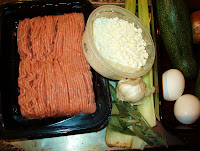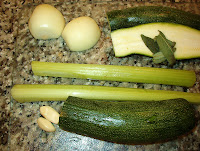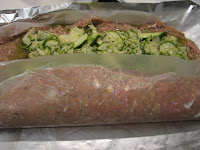 |
| Above: All my ingredients for a great dinner! |
I’ve been craving a meatloaf but I also want to keep the fat down – solution? Turkey meat loaf made with 94% fat-free fresh ground turkey – and since turkey can be dry, I’m going to stuff it (thus the roulade) – this will keep it moist and make it stellar.
What I’ll need: 2 eggs, 2 zucchini (or 3 carrots), 1 lb of ground turkey, some rye bread crumbs, ½ cup oatmeal, some crumbled goat cheese, 1 large yellow onion, 2 celery stalks, 2 cloves of raw garlic and fresh herbs.
Side dish: Smashed Yukon gold potatoes, a bright green salad (arugula – I’m addicted to it and its in season, a granny smith apple) and I have a ¼ bottle of Cabernet left from Valentine’s Day – I’ll make a red wine reduction with it. It sounds fancy but don’t be fooled – it’s easy and you’ll feel like a Master Chef!
 |
| Veggie prep is easy - just remember to seek flat surfaces for stability and safety. |
BACK TO BASICS NOTE: Whenever we slice anything we always seek a flat surface. Cut round veggies in half – place the flat side down for stability. This saves fingers!
The veggie prep: wash the zucchini, the herbs (sage) and the celery. Cut off the tops and the bottoms. Peel the onion and the garlic – rough cut these. I have a wonderful little grinder – I want these minced.
 |
| Simply rough cut the onions, garlic and sage leaves. |
 |
| The first pulse leaves everything minced... perfect! |
I’m going to put the celery through my food processor with the grater attachment. Take out any fibers – you don’t want them in the mix. The grated celery will add another element of flavor and moisture to the turkey so it’s worth the trouble. If you don’t have a food processor, simply chop it extra fine.
 |
| Everything is now ready to blend gently with a spatula. |
Above: the ground turkey, goat cheese, oatmeal, grated celery, minced onion/garlic/sage + a dash of cayenne (for heat and depth of flavor), a dash of allspice (or fresh ground nutmeg), 1/2 teaspoon of salt and 1 teaspoon pepper – read to mix.
Mix everything fully but don’t overwork it (makes it tough). At this point the mix is going to be wet – add the crumbs – a bit at a time, till it all holds together. It resembles bread batter when it's right.
 |
| perfect consistency - moist but holds together. |
Note: You’ll know when it’s at the right consistency because the mixwill pull away from the bowl
Now, I can focus on the stuffing. I use the food processor to grate the zucchini – a hand-held grater will also work – but will take a bit more time and care. Cut them in half and push them through – voila! Toss the grated zucchini into another bowl, add an egg white (toss the yolk), add salt, pepper, cayenne or red pepper flakes to taste – grate a bit of fresh nutmeg for brightness and the remainder of the minced onion mixture.
 |
| The stuffing is prepped and ready to mix. |
Note: The egg white will help bind it. It is a bit wet, and that’s okay. If you use carrots instead, the stuffing will be dryer.
BACK TO BASICS Note: having good tools in the kitchen makes easier work of it all. Get an electric grinder, a food processor, they really are great timesavers.
Now we’re going to assemble. Use aluminum foil to cover a baking sheet. Place another sheet shiny side down, here you can use a little spray oil, or simply brush on some olive oil to the foil. This will help it all release later. Spread the turkey mixture out onto the wax paper. Try to get an even thickness and a rectangular shape. Next, spread the zucchini stuffing mixture just short of the edges also, as evenly as possible.
 |
| Be playful here - it's like coloring - you want to stay inside the lines of the rectangular turkey mix. |
Now, it’s ready to assemble. To make the roulade (it’s like a turkey jelly roll), use the wax paper as a guide. Lift it up and as you lift, you move everything evenly to the center of the baking dish. Oiling the bottom piece of foil serves 2 purposes. It will keep the roulade from sticking later, and it makes it slide now.
 |
| easy does it....nice and steady. |
Keep rolling until the seam is on the bottom. Use the wax paper to even it all out and seal the ends. The zucchini mixture is watery – sop up the excess with paper towels – if you don’t, the liquid will keep your meatloaf from sealing shut. Not a disaster, but it won’t be pretty. Pat the outside of the loaf dry, and make sure to close off the ends. Use your fingers. Also, if it's a bit lopsisded, use the wax paper to help round it out and form it.
Finally, to seal in the flavors, sprinkle some seasoned flower over it. (1/4 cup of white flour with salt, pepper, cayenne and thyme – all whisked together). The flower will help seal in the juices.
 |
| I'm going to tent it with foil and then bake it. |
Tent it with foil (make a crease down the center of you foil to keep it off the meat – and place into a preheated 350F oven for 35 minutes.
While the loaf bakes, slice the Yukon gold potatoes and a peeled clove of garlic + an herb from your theme of the night (thyme, oregano or sage). Rough cut them evenly and cover with water. Add a generous dose (a heaping tbsp) of kosher salt. Boil till a knife goes in easily. Drain the water, add a dollop of light sour cream and smash it all thoroughly (you now have garlic smashed potatoes).
 |
| boil the evenly cut potatoes on med-high till they're fork tender. |
Put the red wine into a small sauce pan and bring to a rolling boil. Add 3 teaspoons of balsamic vinegar, a touch of salt, some fresh black pepper and a spring of sage. Also add a good tablespoon of strawberry or black raspberry jam (this is a trick I learned from very good Danish friends) – and as it reduces by half, it becomes glossy and fantastic. Add a pat of butter and voila: red wine reduction extraordinaire!
 |
| this red wine reduction will make you feel very "Mater Chef"!!! |
Peel and slice the apple for the salad. I’ve got some of my go-to vinaigrette in the fridge – dress the apple with the dressing (the acid in the dressing keeps it from going brown). Prep the greens (arugula) and compose the salad (make it pretty) by laying the apple slices on top.
 |
| The salad is prepped, the wine is flowing, the red wine reduction is glossy - dinner is done! |
BTW: I’m sharing this meal with a friend who is a Master Chef in his own right. But, no worries – this is a foolproof crowd pleaser.
Uncover the loaf and brush on any juices – this final basting will help it brown. Put back into the oven for 10-15 minutes. Then, take your roulade out of the oven and allow it to rest for 15 minutes.
I began this meal with the salad… American style. Next came the turkey roulade with smashed garlic potatoes and a drizzle of my red wine reduction made it all spectacular! Please join me on this journey from my kitchen to you table - Enjoy!
 |
| Let it rest before you slice it. It's the secret to juicy meat, pork, lamb and chicken dishes. |
 |
| See: guilt free and lots of TADA! |
This is a meatloaf is jam packed with so much flavor… you’ll stay up daydreaming about the leftovers. Note: it slices even better cold for lunch the next day.
This is truly meat and potatoes with zero guilt and quite a bit of TADAH!
NOTE: If you use carrots instead of zucchini, grate and toss with a bit of brown sugar for added depth of flavor. The carrots are drier at the start, but the result will be the same, a moist delicious treat for the eyes that is an upgrade on a meatloaf.
 |
| Here's the carrot filled version - an excellent lunch served with red cabbage and carrot salad |
Always feel free to send me your questions. Are you trying any of these recipes out? I’d love to hear how it goes for you.































